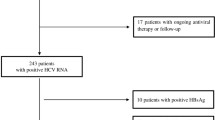Abstract
We studied the course of infection with human immunodeficiency virus type 1 (HIV-1) in relation to apolipoprotein E (APOE) polymorphism found for 209 Italians treated at Infectious Disease Clinics in Rome and Modena. Clinically, patients were classified into four groups according to the yearly rate of decline in CD4+ cell count (LTNP: long-term non-progression; SLOW, ’NORMAL’ or RAPID). Patients at both extremes of the clinical spectrum, i.e. those who rapidly progressed to AIDS and those with stable high CD4 cell counts, had few APOE ɛ4 and ɛ2 alleles (P = 0.04). Detailed clinical information was then used to construct four model-based clinical profiles using grade-of-membership analysis (GoM), predictive of APOE genotypic frequencies: 1. The clinical profile associated with good long-term prognosis lacked ɛ2 (P=0.01); 2. Disease progression to AIDS was associated with ɛ4 and ɛ2, most evident for zidovudine-lamivudine regimens without a protease inhibitor (P = 0.03); and, 3. AIDS patients had low ɛ4 and ɛ2 frequencies, consistent with a high mortality rate among ɛ4+ and ɛ2+ AIDS patients. These findings suggest allele-specific immunomodulatory effects involving inherited APOE isoform important enough to alter the clinical course of HIV infection and, possibly, drug efficacy. They imply a connection between lipid metabolism and immunity potentially relevant to common disorders.
Similar content being viewed by others
References
R.W. Mahley: “Apolipoprotein E: cholesterol transport protein with expanding role in cell biology”, Science, Vol. 240 (1988), pp. 622–630.
E.M. Avila, G. Holdsworth, N. Sasaki, R.L. Jackson and J.A. Harmony: “Apoprotein E suppresses phytohemagglutinin-activated phospholipid turnover in peripheral blood mononuclear cells”, J. Biol. Chem., Vol. 257, (1982), pp. 5900–5909.
M.G. Pepe and L.K. Curtiss: “Apolipoprotein E is a biologically active constituent of the normal immunoregulatory lipoprotein, LDL-In”, J. Immunol., Vol. 136, (1986), pp. 3716–3723.
L.K. Curtiss and T.S. Edgington: “The biologic activity of the immunoregulatory lipoprotein, LDL-In is independent of its free fatty acid content”, J. Immunol., Vol 126, (1981), pp. 1382–1386.
R.A. Terkeltaub, C.A. Dyer, J. Martin and L.K. Curtiss: “Apolipoprotein (apo) E inhibits the capacity of monosodium urate crystals to stimulate neutrophils. Characterization of intraarticular apo E and demonstration of apo E binding to urate crystals in vivo”, J. Clin. Invest., Vol. 87, (1991), pp. 20–26.
N. de Bont, P.N. Demacker, B.J. Kullberg, J.W. van der Meer and A.F. Stalenhoef: “Apolipoprotein E-deficient mice have an impaired immune response to Klebsiella pneumoniae”, Eur. J. Clin. Invest., Vol. 30, (2000), pp. 818–822.
S.E. Roselaar and A. Daugherty: “Apolipoprotein E-deficient mice have impaired innate immune responses to Listeria monocytogenes in vivo”, J. Lipid. Res., Vol 39, (1998), pp. 1740–1743.
D.T. Laskowitz, D.M. Lee, D. Schmechel and H.F. Staats: “Altered immune responses in apolipoprotein E-deficient mice”, J. Lipid. Res., Vol. 41, (2000), pp. 613–620.
B. Ludewig, M. Jäggi, T. Dumrese, K. Brduscha-Riem, B. Odermatt, H. Hengartner and R.M. Zinkernagel: “Hypercholesterolemia exacerbates virus-induced immunopathologic liver disease via suppression of antiviral cytotoxic T cell responses”, J. Immunol., Vol. 166, (2001), pp. 3369–3376.
T. Kuusi, M.S. Nieminen, C. Ehnholm, H. Yki-Järvinen, M. Valle, E.A. Nikkilä and M.R. Taskinen: “Apolipoprotein E polymorphism and coronary artery disease: increased prevalence of apolipoprotein E-4 in angiographically verified coronary patients”, Arteriosclerosis, Vol. 9, (1989), pp. 237–241.
G. Utermann, A. Hardewig and F. Zimmer: “Apolipoprotein E phenotypes in patients with myocardial infarction”, Hum. Genet., Vol. 65, (1984), pp. 237–241.
E.H. Corder, H. Basun, L. Fratiglioni, Z. Guo, L. Lannfelt, M. Viitanen, L.S. Corder, K.G. Manton and B. Winblad: “Inherited frailty. ApoE alleles determine survival after a diagnosis of heart disease or stroke at ages 85+”, Ann. N. Y. Acad. Sci., Vol. 908, (2000), pp. 295–298.
A.M. Saunders, W.J. Strittmatter, D. Schmechel, P.H. George-Hyslop, M.A. Pericak-Vance, S.H. Joo, B.L. Rosi, J.F. Gusella, D.R. Crapper-MacLachlan and M.J. Alberts: “Association of apolipoprotein E allele e4 with late onset familial and sporadic Alzheimer’s disease”, Neurology, Vol. 43, (1993), pp. 1467–1472.
W.J. Strittmatter, K.H. Weisgraber, D.Y. Huang, L.M. Dong, G.S. Salvesen, M. Pericak-Vance, D. Schmechel, A.M. Saunders, D. Goldgaber and A.D. Roses: “Apolipoprotein E: high-avidity binding to beta-amyloid and increased frequency of type 3 allele in late-onset familial Alzheimer disease”, Proc. Natl. Acad. Sci. USA, Vol. 90, (1993), pp. 1977–1981.
E.H. Corder, A.M. Saunders, W.J. Strittmatter, D.E. Schmechel, P.C. Gaskell, G.W. Small, A.D. Roses, J.L. Haines and M.A. Pericak-Vance: “Gene dose of apolipoprotein E type 4 allele and the risk of Alzheimer’s disease in late onset families”, Science, Vol. 261, (1993), pp. 921–923.
C. Ballerini, D. Campani, G. Rombola, B. Gran, B. Nacmias, M.P. Amato, G. Siracusa, L. Bartolozzi, S. Sorbi and L. Massacesi: “Association of apolipoprotein E polymorphism to clinical heterogeneity of multiple sclerosis”, Neurosci. Lett., Vol. 296, (2000), pp. 174–176.
T. Masterman, J. Hillert, L. Lannfelt and E.H. Corder: “The 4 allele for APOE doubles the risk of poor long-term prognosis in multiple sclerosis”, Am. J. Hum. Genet., Vol. 67, (2000), pp. S1957.
J. Chapman, S. Vinokurov, A. Achiron, D.M. Karussis, K. Mitosek-Szewczyk, M. Birnbaum, D.M. Michaelson and A.D. Korczyn: “APOE genotype is a major predictor of long-term progression of disability in MS”, Neurology, Vol. 56, (2001), pp. 312–316.
H. Akiyama, S. Barger, S. Barnum, B. Bradt, J. Bauer, G.M. Cole, N.R. Cooper, P. Eikelenboom, M. Emmerling, B.L. Fiebich, C.E. Finch, S. Frautschy, W.S. Griffin, H. Hampel, M. Hull, G. Landreth, L. Lue, R. Mrak, I.R. Mackenzie, P.L. McGeer, M.K. O’Banion, J. Pachter, G. Pasinetti, C. Plata-Salaman, J. Rogers, R. Rydel, Y. Shen, W. Streit, R. Strohmeyer, I. Tooyoma, F.L. Van Muiswinkel, R. Veerhuis, D. Walker, S. Webster, B. Wegrzyniak, G. Wenk and T. Wyss-Coray: “Inflammation and Alzheimer’s disease”, Neurobiol. Aging, Vol. 21, (2000), pp. 383–421.
D.T. Laskowitz, A.D. Thekdi, S.D. Thekdi, S.K. Han, J.K. Myers, S.V. Pizzo and E.R. Bennett: “Downregulation of microglial activation by apolipoprotein E and apoE-mimetic peptides”, Exp. Neurol., Vol. 167, (2001), pp. 74–85.
J.R. Lynch, D. Morgan, J. Mance, W.D. Matthew and D.T. Laskowitz: “Apolipoprotein E modulates glial activation and the endogenous central nervous system inflammatory response”, J. Neuroimmunol., Vol. 114, (2001), pp. 107–113.
R.F. Itzhaki, W.R. Lin, D. Shang, G.K. Wilcock, B. Faragher and G.A. Jamieson: “Herpes simplex virus type 1 in brain and risk for Alzheimer’s disease”, Lancet, Vol. 349, (1997), pp. 241–244.
S. Sorbi, B. Nacmias, S. Piacentini, A. Repice, S. Latorraca, P. Forleo and L. Amaducci: “ApoE as a prognostic factor for post-traumatic coma”, Nat. Med., Vol. 1, (1995), pp. 852.
E.H. Corder, K. Robertson, L. Lannfelt, N. Bogdanovic, G. Eggertsen, J. Wilkins, C. Hall: “HIV-infected subjects who carry the E4 allele for APOE have excess dementia and peripheral neuropathy”, Nat. Med., Vol. 4, (1998), pp. 1182–1184.
Y. Liu, M. Jones, C.M. Hingtgen, G. Bu, N. Laribee, R.E. Tanzi, R.D. Moir, A. Nath and J.J. He: “Uptake of HIV-1 tat protein mediated by low-density lipoprotein receptor-related protein disrupts the neuronal metabolic balance of the receptor ligands”, Nat. Med., Vol. 6, (2000), pp. 1380–1387.
C. Grunfeld: “Abnormalities of apolipoprotein E in the acquired immunodeficiency syndrome”, J. Clin. Endocrinol. Metab., Vol. 82, (1997), pp. 3734–3740.
G. Carrieri, M. Bonafe, M. De Luca, G. Rose, O. Varcasia, A. Bruni, R. Maletta, B. Nacmias, S. Sorbi, F. Corsonello, E. Feraco, K.F. Andreev, A.I. Yashin, C. Franceschi and G. De Benedictis: “Mitochondrial DNA haplogroups and APOE4 allele are non-independent variables in sporadic Alzheimer’s disease”, Hum. Genet., Vol. 108, (2001), pp. 194–198.
E. Girardi, A. Sampaolesi, M. Gentile, G. Nurra and G. Ippolito: “Increasing proportion of late diagnosis of HIV infection among patients with AIDS in Italy following introduction of combination antiretroviral therapy”, J. Acquir. Immune Defic. Syndr., Vol. 25, (2000), pp. 71–76.
O. Dunlop, A.K. Goplen, K. Liestol, B. Myrvang, H. Rootwelt, B. Christophersen, E.A. Kvittingen and J. Maehlen: “HIV dementia and apolipoprotein E”, Acta Neurol. Scand., Vol. 95, (1997), pp. 315–318.
X. Gao, G.W. Nelson, P. Karacki, M.P. Martin, J. Phair, R. Kaslow, J.J. Goedert, S. Buchbinder, K. Hoots, D. Vlahov, S.J. O’Brien and M. Carrington: “Effect of a single amino acid change in MHC class 1 molecutes on the rate of progression to AIDS”, N. Engl. J. Med., Vol. 344, (2001), pp. 1668–1675.
R.K. Lister, M. Youle, D.R. Nair, A.F. Winder and M.H.A. Rustin: “Latent dysbetalipoproteinaemia precipitated by HIV-protease inhibitors”, Lancet, Vol. 353, (1999), pp. 1678.
E. Bonnet, J.B. Ruidavets, J. Tuech, J. Ferrieres, X. Collet, J. Fauvel, P. Massip and B. Perret: “Apoprotein C-III and E-containing lipoparticles are markedly increased in HIV-infected patients treated with protease inhibitors: association with the development of lipodystrophy”, J. Clin. Endocrinol. Metab., Vol. 86, (2001), pp. 296–302.
L.U. Gerdes, C. Gerdes, K. Kervinen, M. Savolainen, I.C. Klausen, P.S. Hansen, Y.A. Kesäniemi and O. Faergeman: “The apolipoprotein epsilon4 allele determines prognosis and the effect on prognosis of simvastatin in survivors of myocardial infarction: a substudy of the Scandinavian simvastatin survival study”, Circulation, Vol. 101, (2000), pp. 1366–1371.
J.E. Hixson and D.T. Vernier: “Restriction isotyping of human apolipoprotein E by gene amplification and cleavage with Hha I”, J. Lipid Res., Vol. 31, (1990), pp. 545–548.
Grade of Membership Software: Center for Demographic Studies, Duke University, Durham, NC (1987).
K.G. Manton, M.A. Woodbury and H.D. Tolley: Statistical Applications Using Fuzzy Sets, John Wiley & Sons, New York (1994).
H. Akaike: “Information theory and an extension of the maximum likelihood principle”, In: Proc. Second Internat. Symp. on Information Theory., Akademiai Kiado, Budapest (1972), pp. 267–281.
Author information
Authors and Affiliations
Corresponding author
About this article
Cite this article
Corder, E.H., Galeazzi, L., Franceschi, C. et al. Differential course of HIV-1 infection and apolipoprotein E polymorphism. cent.eur.j.med 2, 404–416 (2007). https://doi.org/10.2478/s11536-007-0039-x
Received:
Accepted:
Issue Date:
DOI: https://doi.org/10.2478/s11536-007-0039-x




